Physicochemical Properties
| Molecular Formula | C8H8CL3NO |
| Molecular Weight | 240.51 |
| Exact Mass | 238.967 |
| CAS # | 10129-56-3 |
| PubChem CID | 224859 |
| Appearance | Light yellow to light brown solid powder |
| Density | 1.465g/cm3 |
| Boiling Point | 342.2ºC at 760mmHg |
| Flash Point | 160.8ºC |
| Vapour Pressure | 2.94E-05mmHg at 25°C |
| Index of Refraction | 1.579 |
| LogP | 2.355 |
| Hydrogen Bond Donor Count | 1 |
| Hydrogen Bond Acceptor Count | 2 |
| Rotatable Bond Count | 2 |
| Heavy Atom Count | 13 |
| Complexity | 154 |
| Defined Atom Stereocenter Count | 0 |
| InChi Key | NGTDJJKTGRNNAU-UHFFFAOYSA-N |
| InChi Code | InChI=1S/C8H8Cl3NO/c9-8(10,11)7(13)5-6-1-3-12-4-2-6/h1-4,7,13H,5H2 |
| Chemical Name | 1,1,1-trichloro-3-pyridin-4-ylpropan-2-ol |
| HS Tariff Code | 2934.99.9001 |
| Storage |
Powder-20°C 3 years 4°C 2 years In solvent -80°C 6 months -20°C 1 month |
| Shipping Condition | Room temperature (This product is stable at ambient temperature for a few days during ordinary shipping and time spent in Customs) |
Biological Activity
| Targets | Caspase 3 |
| ln Vitro | In a dose-dependent manner, PETCM (0.1–0.5 mM) increases the caspase-3 activity (DEVD activity) of HeLa S-100. Furthermore, 0.2 mM PETCM is more effective in activating caspase-3 than 1 mM dATP[1]. Apoptosome formation is stimulated by PETCM (0.2 mM; 1 hour). In a typical HeLa cell S-100 fraction, Apaf-1 exists as an inactive monomeric form. When exposed to 1 mM dATP, the majority of Apaf-1 shifted to a 1 million dalton size. Similar shift is seen in Apaf-1 after the S-100 fraction with 0.2 mM PETCM. Additionally, using 0.2 mM PETCM improved the efficiency of apoptosome formation[1]. The inhibitory effect of ProT decreased caspase-3 activation in HeLa cells can be countered by PETCM (0.2 mM; 1 hour)[1]. |
| Cell Assay |
Western Blot Analysis[1] Cell Types: HeLa cells Tested Concentrations: 0.2 mM Incubation Duration: 1 hour Experimental Results: Increased apoptosome formation. |
| References |
[1]. Direct activation of the apoptosis machinery as a mechanism to target cancer cells.Proc Natl Acad Sci U S A. 2003 Jun 24;100(13):7533-8. [2]. Distinctive roles of PHAP proteins and prothymosin-alpha in a death regulatory pathway. Science, 2003, 299(5604): 223-226. |
| Additional Infomation | 1,1,1-trichloro-3-pyridin-4-yl-2-propanol is a member of pyridines. |
Solubility Data
| Solubility (In Vitro) | DMSO : 100 mg/mL (415.78 mM) |
| Solubility (In Vivo) |
Solubility in Formulation 1: ≥ 2.5 mg/mL (10.39 mM) (saturation unknown) in 10% DMSO + 40% PEG300 + 5% Tween80 + 45% Saline (add these co-solvents sequentially from left to right, and one by one), clear solution. For example, if 1 mL of working solution is to be prepared, you can add 100 μL of 25.0 mg/mL clear DMSO stock solution to 400 μL PEG300 and mix evenly; then add 50 μL Tween-80 to the above solution and mix evenly; then add 450 μL normal saline to adjust the volume to 1 mL. Preparation of saline: Dissolve 0.9 g of sodium chloride in 100 mL ddH₂ O to obtain a clear solution. Solubility in Formulation 2: ≥ 2.5 mg/mL (10.39 mM) (saturation unknown) in 10% DMSO + 90% (20% SBE-β-CD in Saline) (add these co-solvents sequentially from left to right, and one by one), clear solution. For example, if 1 mL of working solution is to be prepared, you can add 100 μL of 25.0 mg/mL clear DMSO stock solution to 900 μL of 20% SBE-β-CD physiological saline solution and mix evenly. Preparation of 20% SBE-β-CD in Saline (4°C,1 week): Dissolve 2 g SBE-β-CD in 10 mL saline to obtain a clear solution. Solubility in Formulation 3: ≥ 2.5 mg/mL (10.39 mM) (saturation unknown) in 10% DMSO + 90% Corn Oil (add these co-solvents sequentially from left to right, and one by one), clear solution. For example, if 1 mL of working solution is to be prepared, you can add 100 μL of 25.0 mg/mL clear DMSO stock solution to 900 μL of corn oil and mix evenly. (Please use freshly prepared in vivo formulations for optimal results.) |
| Preparing Stock Solutions | 1 mg | 5 mg | 10 mg | |
| 1 mM | 4.1578 mL | 20.7892 mL | 41.5783 mL | |
| 5 mM | 0.8316 mL | 4.1578 mL | 8.3157 mL | |
| 10 mM | 0.4158 mL | 2.0789 mL | 4.1578 mL |
